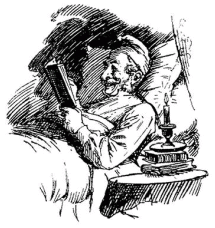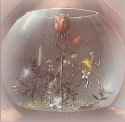
The
World's Most
Mysterious Book
The Voynich Manuscript
Some quotes about the
Voynich Manuscript
 "The Voynich Manuscript,
which has been dubbed 'The Most Mysterious Manuscript in the
World', is named after its discoverer, the American antique
book dealer and collector, Wilfrid M. Voynich, who discovered
it in 1912, amongst a collection of ancient manuscripts kept
in villa Mondragone in Frascati, near Rome, which had been by
then turned into a Jesuit College (closed in 1953). Wilfrid
Voynich judged it to date from the late 13th century, on the
evidence of the calligraphy, the drawings, the vellum, and the
pigments. It is some 200 pages long, written in an unknown script
of which there is no known other instance in the world. It is
abundantly illustrated with awkward coloured drawings. Drawings
of unidentified plants; of what seems to be herbal recipes;
of tiny naked women frolicking in bathtubs connected by intricate
plumbing looking more like anatomical parts than hydraulic contraptions;
of mysterious charts in which some have seem astronomical objects
seen through a telescope, some live cells seen through a microscope;
of charts into which you may see a strange calendar of zodiacal
signs, populated by tiny naked people in rubbish bins." - Jacques Guy, (jbm@tardis.trl.OZ.AU)
"The Voynich Manuscript,
which has been dubbed 'The Most Mysterious Manuscript in the
World', is named after its discoverer, the American antique
book dealer and collector, Wilfrid M. Voynich, who discovered
it in 1912, amongst a collection of ancient manuscripts kept
in villa Mondragone in Frascati, near Rome, which had been by
then turned into a Jesuit College (closed in 1953). Wilfrid
Voynich judged it to date from the late 13th century, on the
evidence of the calligraphy, the drawings, the vellum, and the
pigments. It is some 200 pages long, written in an unknown script
of which there is no known other instance in the world. It is
abundantly illustrated with awkward coloured drawings. Drawings
of unidentified plants; of what seems to be herbal recipes;
of tiny naked women frolicking in bathtubs connected by intricate
plumbing looking more like anatomical parts than hydraulic contraptions;
of mysterious charts in which some have seem astronomical objects
seen through a telescope, some live cells seen through a microscope;
of charts into which you may see a strange calendar of zodiacal
signs, populated by tiny naked people in rubbish bins." - Jacques Guy, (jbm@tardis.trl.OZ.AU)  "Dating at least
to 1586, the manuscript is written in a language of which no
other example is known to exist. It is an alphabetic script,
but of an alphabet variously reckoned to have from nineteen
to twenty-eight letters, none of which bear any relationship
to any English or European letter system. The manuscript is
small, seven by ten inches, but thick, nearly 170 pages. It
is closely written in a free-running hand and copiously illustrated
with bizarre line drawings that have been water-colored: drawings
of plants, drawings of little naked ladies appearing to take
showers in a strange system of plumbing (variously identified
as organs of the body or a primitive set of fountains), and
astrological drawings - or what have been interpreted as astrological
drawings. Since the Voynich Manuscript is at the Beinecke Rare
Book Room at Yale [catalogue number MS 408], it is accessible
to any serious scholar." - Terence McKenna, The Archaic
Revival
"Dating at least
to 1586, the manuscript is written in a language of which no
other example is known to exist. It is an alphabetic script,
but of an alphabet variously reckoned to have from nineteen
to twenty-eight letters, none of which bear any relationship
to any English or European letter system. The manuscript is
small, seven by ten inches, but thick, nearly 170 pages. It
is closely written in a free-running hand and copiously illustrated
with bizarre line drawings that have been water-colored: drawings
of plants, drawings of little naked ladies appearing to take
showers in a strange system of plumbing (variously identified
as organs of the body or a primitive set of fountains), and
astrological drawings - or what have been interpreted as astrological
drawings. Since the Voynich Manuscript is at the Beinecke Rare
Book Room at Yale [catalogue number MS 408], it is accessible
to any serious scholar." - Terence McKenna, The Archaic
Revival
 "Historically, it
first appears in 1586 at the court of Rudolph II of Bohemia,
who was one of the most eccentric European monarchs of that
or any other period. Rudolph collected dwarfs and had a regiment
of giants in his army. He was surrounded by astrologers, and
he was fascinated by games and codes and music. He was typical
of the occult-oriented, Protestant noblemen of this period and
epitomized the liberated northern European prince. he was a
patron of alchemy and supported the printing of alchemical literature.
The Rosicrucian conspiracy was being quietly fomented during
this same period." "To Rudolph's court came an unknown person
who sold this manuscript to the king for three hundred gold
ducats, which, translated into modern monetary units, is about
fourteen thousand dollars. This is an astonishing amount of
money to have paid for a manuscript at that time, which indicated
that the Emperor must have been highly impressed by it. Accompanying
the manuscript was a letter that stated that it was the work
of the Englishman Roger Bacon, who flourished in the thirteenth
century and who was a noted pre-Copernican astronomer." "Only
two years before the appearance of the Voynich Manuscript, John
Dee, the great English navigator, astrologer, magician, intelligence
agent, and occultist had lectured in Prague on Bacon." - Terence McKenna, The Archaic Revival
"Historically, it
first appears in 1586 at the court of Rudolph II of Bohemia,
who was one of the most eccentric European monarchs of that
or any other period. Rudolph collected dwarfs and had a regiment
of giants in his army. He was surrounded by astrologers, and
he was fascinated by games and codes and music. He was typical
of the occult-oriented, Protestant noblemen of this period and
epitomized the liberated northern European prince. he was a
patron of alchemy and supported the printing of alchemical literature.
The Rosicrucian conspiracy was being quietly fomented during
this same period." "To Rudolph's court came an unknown person
who sold this manuscript to the king for three hundred gold
ducats, which, translated into modern monetary units, is about
fourteen thousand dollars. This is an astonishing amount of
money to have paid for a manuscript at that time, which indicated
that the Emperor must have been highly impressed by it. Accompanying
the manuscript was a letter that stated that it was the work
of the Englishman Roger Bacon, who flourished in the thirteenth
century and who was a noted pre-Copernican astronomer." "Only
two years before the appearance of the Voynich Manuscript, John
Dee, the great English navigator, astrologer, magician, intelligence
agent, and occultist had lectured in Prague on Bacon." - Terence McKenna, The Archaic Revival
 "The manuscript
somehow passed to Jacobus de Tepenecz, the director of Rudolph's
botanical gardens (his signature is present in folio 1r) and
it is speculated that this must have happened after 1608, when
Jacobus Horcicki received his title 'de Tepenecz'. Thus 1608
is the earliest definite date for the Manuscript." -
Dennis Stallings , "Voynich mini-FAQ"
"The manuscript
somehow passed to Jacobus de Tepenecz, the director of Rudolph's
botanical gardens (his signature is present in folio 1r) and
it is speculated that this must have happened after 1608, when
Jacobus Horcicki received his title 'de Tepenecz'. Thus 1608
is the earliest definite date for the Manuscript." -
Dennis Stallings , "Voynich mini-FAQ"
"Codes from the
early sixteenth century onward in Europe were all derived from
The Stenographica of Johannes Trethemius, Bishop of Sponheim,
an alchemist who wrote on the encripherment of secret messages.
He had a limited number of methods, and no military, alchemical,
religious, or political code was composed by any other means
throughout a period that lasted well into the seventeenth century.
Yet the Voynich Manuscript does not appear to have any relationship
to the codes derivative of Johannes Trethemius, Bishop of Sponheim." - Terence McKenna, The Archaic Revival
|
|








